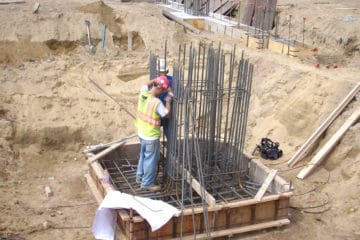Geo Tech Engineer: Enhancing Site Evaluations with Advanced Geotechnical Techniques
Geo Tech Engineer: Enhancing Site Evaluations with Advanced Geotechnical Techniques
Blog Article
The Interdisciplinary Approaches in the Geotechnical Market: Linking the Space In Between Design, Geology, and Environmental Scientific Research for Ideal Task Results
The combination of engineering, geology, and ecological science within the geotechnical industry is not just advantageous; it is critical for attaining optimum task results. What techniques might emerge to promote this crucial cooperation and boost the efficiency of geotechnical techniques?
Importance of Interdisciplinary Cooperation
The significance of interdisciplinary collaboration in the geotechnical market can not be overemphasized. Effective geotechnical tasks need the integration of diverse expertise from numerous areas, consisting of engineering, geology, and ecological scientific research. This collaboration guarantees that all facets of a project are taken into consideration, bring about extensive remedies that deal with intricate difficulties.
When functioning in seclusion,Interdisciplinary collaboration cultivates development by allowing specialists to share insights and methods that may not be evident. By leveraging the strengths of several techniques, groups can identify prospective threats, optimize layout processes, and improve the sustainability of geotechnical jobs. Moreover, such partnership advertises a holistic understanding of site-specific problems, which is essential for precise analysis and decision-making.
The intricacy of geotechnical projects demands a collaborated technique to analytical. Ultimately, interdisciplinary partnership is important for advancing ideal practices and accomplishing excellence in the geotechnical industry.
Secret Functions of Each Technique
Collaboration among different self-controls is not simply advantageous; it is vital for the successful implementation of geotechnical jobs. Each discipline-- design, geology, and ecological science-- plays a distinct yet interconnected role that adds to forecast effectiveness and sustainability.
Geotechnical designers are mostly liable for designing foundations and ensuring structural integrity. They examine dirt and rock homes to assess load-bearing capabilities, providing essential information for risk-free construction techniques. Their competence enables the formulation of innovative remedies to intricate obstacles.

Environmental scientists examine the prospective impacts of construction on ecosystems and water sources. They carry out environmental analyses and develop mitigation methods to decrease negative effects. By integrating environmental considerations, they ensure conformity with policies and promote sustainability throughout the job lifecycle.
Situation Researches of Effective Integration
Effective integration of geotechnical techniques can be exhibited through numerous study that highlight the effectiveness of teamwork in dealing with complex engineering difficulties. One noteworthy instance is the construction of the Hong Kong-- Zhuhai-- Macau Bridge, where a joint approach involving geotechnical engineering, geology, and ecological scientific research was essential. Rock hounds and engineers functioned in unison to evaluate the seabed problems and optimize the foundation style, guaranteeing security and minimizing ecological influence.
Another impactful situation is the improvement of slope security in the San Francisco Bay Location, where an interdisciplinary group integrated geotechnical evaluation with ecological assessments. By integrating hydrological research studies and geological studies, the team successfully determined possible landslide risks and carried out efficient reduction actions, boosting safety and security and sustainability.
Additionally, the redevelopment of Brownfield websites often needs a multidisciplinary method. In one situation in Chicago, cooperation among geotechnical engineers, ecological scientists, and urban organizers led to the effective removal of infected soil, allowing for the safe change of the site into a community park. These study illustrate that interdisciplinary collaboration not just addresses technical difficulties but additionally fosters innovative solutions that profit both projects and communities.
Obstacles in Multidisciplinary Projects

Furthermore, working with schedules and operations among various teams can be problematic, specifically when each technique has special project milestones and deliverables. This imbalance can lead to delays and raised prices. The challenge of source allowance also looms large; ensuring that specific know-how is offered at crucial times calls for cautious planning and insight.
Finally, regulatory compliance postures another significant difficulty. Each technique may face different governing frameworks, and aligning these requirements to satisfy project purposes can be taxing and intricate. Dealing with these obstacles requires strong management and effective interaction strategies to promote partnership and make certain that multidisciplinary teams work cohesively in the direction of shared goals.
Future Trends in Geotechnical Practices
As the geotechnical sector develops, view it emerging trends are reshaping practices to resolve the difficulties encountered in multidisciplinary projects - geo tech engineer. One significant fad is the raised integration of advanced modern technologies, such as expert system and artificial intelligence, right into geotechnical evaluation and design. These technologies enhance predictive modeling and danger assessment, allowing engineers to make even more informed decisions throughout the project lifecycle
.webp)
Additionally, the adoption of electronic doubles and real-time surveillance systems is coming to be extra prevalent. These devices help with continuous assessment of soil problems and architectural efficiency, enabling prompt treatments when issues emerge.
Conclusion
To conclude, the integration of engineering, geology, and ecological scientific research is crucial for achieving optimum results in the geotechnical industry. Interdisciplinary cooperation promotes advancement, improves analytical capacities, and straightens technological demands with ecological sustainability. Successful case studies illustrate the benefits of this strategy, while recognizing the obstacles dealt with in multidisciplinary jobs. Looking ahead, embracing these collaborative techniques will certainly be essential for navigating future trends and progressing the area of geotechnical design.
The assimilation of engineering, geology, and ecological science within the geotechnical sector is not merely useful; it is important for accomplishing optimum project outcomes. Efficient geotechnical tasks require the combination of diverse experience from various areas, consisting of design, geology, and environmental science.Navigating the intricacies of multidisciplinary projects in the geotechnical industry provides several considerable challenges.As the geotechnical sector advances, emerging fads are anonymous improving practices to resolve the obstacles dealt with in multidisciplinary jobs. Geotechnical engineers are increasingly working together with ecological researchers to guarantee that jobs straighten with sustainability objectives and conform with governing demands.
Report this page